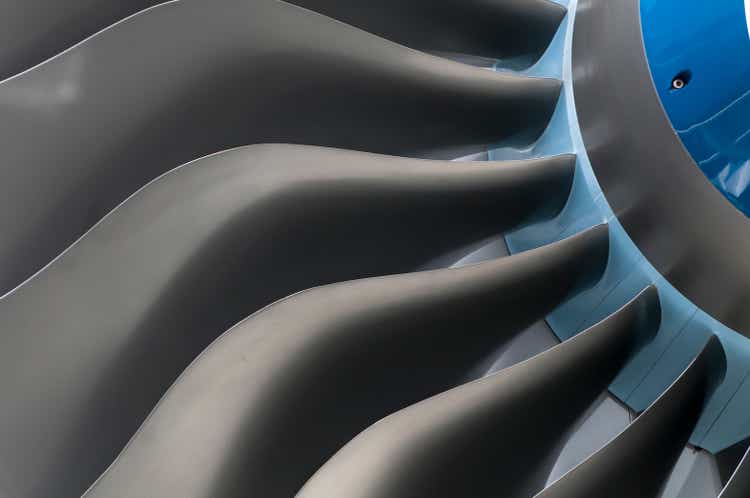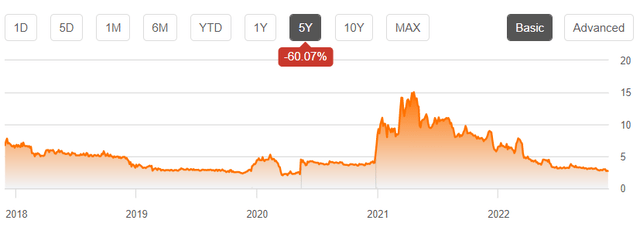Brasil2/E+ via Getty Images
SIFCO Industries (NYSE:SIF) is nothing if not volatile. I wrote an initial interest article about the company two years ago when the stock was trading at $3.80. The stock ran up as high as $14/share, but has now collapsed to $2.70 at the time of this writing. The company has an asset-heavy balance sheet, minimal cash burn, and a history of cyclical earnings. I’m a buyer below $3/share.
Quick Company Recap
I did a more robust look at SIF’s business model in my previous article, but as a quick recap, the company was founded over 100 years ago and manufactures turbines, turbine blades, and other aerospace components for military and commercial aircraft. Like clockwork, the company generates somewhere between $80 and $120 million a year in revenue, either earns a small profit or incurs a small loss, and generates a little bit of cash flow. Despite multiple acquisitions, dispositions, write-downs, and attempts at product diversification, the company’s financials are virtually the same today as they were in the late 90s. Margins are slim in both good and bad times, with any given year’s performance being determined primarily by the mix of contracts they receive. I see no evidence of pricing power in the company’s financials, nor much of a moat around their product offerings, but I think SIF has staying power and has been able to weather all the economic storms it has encountered thus far.
What Has Changed Since My Last Writeup
SIF’s situation has changed in two ways since my previous article. First, the company has moved from GAAP profitability to GAAP losses. In SIF’s fiscal 2020 (the company’s fiscal year ends Sept 30th), the company generated $1.60/share in net income. In fiscal year 2021, SIF lost $.13/share and through the first nine months of fiscal year 2022 they have lost $.46/share. SIF is suffering from higher input costs that they have not been able to pass along to their customers. Gross margins are a mere 3% over the last nine months. Operating cash flow is still barely positive, but free cash flow has also turned negative.
The other major change is the company’s share price. As mentioned in the introduction, SIF went on a wild ride after 2020 full-year earnings were released. Prices nearly reached $15/share before beginning a slow decline back down to today’s current level:
SIFCO Stock Performance (5-yr) (Seeking Alpha)
SIF is trading at $2.70/share at the time of this writing, equating to a market cap of roughly $16mm.
3 Reasons I am Bullish
If SIF is posting significant losses and its stock price is in decline, why am I buying shares in the company? First and foremost, I’m interested in SIF because I believe it is trading cheaply relative to the value of its assets. SIF doesn’t have a lot of cash, but does have a high current asset value of $42mm against current liabilities of just $30mm (as of June). I am willing to accept the stated $40mm value of PP&E, as much of the company’s equipment is new within the last 3 years (due mostly to a fire in late 2018 that destroyed their Orange, California factory and forced investment in new equipment). Cutting out all other assets (goodwill, operating lease assets, etc.) gives SIF $82mm in assets against $55mm in total liabilities (even including the operating lease obligation), for an adjusted book value of $27mm. SIF’s market cap at the time of this writing is a mere $16mm, so I am comfortable with the downside protection provided by the asset base.
Second, I believe SIF will return to profitability sometime in the next year and that the reaction in the share price will be swift and strong. Recent earnings have been negatively impacted primarily by supply chain difficulties, project mix, and inflationary pressure. SIF experienced delays in receiving particular items from suppliers and had trouble with staffing, leading to lower utilization rates and decreased throughput. There has also been a notable shrinkage in government contract work in 2022, due in part to the timing of the contracts being awarded but also due to SIF not being able to meet all the requirements for some of the contracts due to the aforementioned operational issues. Management also noted that increased energy costs have been a meaningful headwind.
I believe these problems are mostly fixable. I will concede that wage inflation is likely going to be sticky, as management has noted the need to increase pay and incentives in order to address staffing problems. However, we are starting to see improvements in the global supply chain and energy prices, though still volatile, have been trending in a positive direction. I realize this is backwards-looking, but SIF has been able to consistently manage gross margins in the low double-digits; the current 3% number is likely an outlier and I expect a reversion to long-term averages. SIF earnings tend to be lumpy year to year, even in “normal” times, so stretches of unprofitability are nothing new for the company. As we saw in 2020, a positive earnings beat at the end of the year was enough to send the share price up over 200% in short order, which makes me suspect that if/when SIF does manage to exceed earnings estimates the share price is likely to react in a big way.
Finally, SIF has minimal cash burn. Through the first 9 months of their fiscal 2022, the company has generated positive cashflow from operations despite nearly $3mm in net GAAP losses. Free cash flow is negative, due to capital expenditures of $2.5mm, but these expenses can be somewhat discretionary in the short term. SIF’s runway isn’t unlimited, but positive cashflow from operations gives some breathing room while net income improves.
Risks
I see three primary risks with a SIF investment. First, SIF has very little cash on hand and relies on contract payments and receivables for operational cash flow. SIF has a lot of value stored in its PP&E assets, but beyond using them as collateral for loans they don’t give the company much cash flow flexibility. A disruption or delay in payments from customers could cause liquidity issues and necessitate taking on short-term debt at unfavorable interest rates.
Second, while SIF’s assets provide some margin of safety, in the event of a full liquidation I would expect SIF investors to lose money (though not to be wiped out). In that scenario I would assume that contract assets go to zero and inventory gets written down 50%. In this scenario investors would be looking at a strict liquidation value of about $10mm (~40% downside), though there is a chance they wouldn’t end up being on the hook for their entire lease balance (which would improve the $10mm value). I think the risk of total ruin is very low, but an investment in SIF isn’t risk free either; there are some scenarios with meaningful downside for investors.
Finally, SIF is a nanocap company; low share liquidity and high daily volatility are going to be part of any SIF investment.
Conclusion
“The challenge in life is knowing what’s next. Earnings have a way of changing, and it’s far more fickle than assets.” – Walter Schloss
This quote from Walter Schloss encapsulates my thinking about SIF. The company has stable assets and minimal cash burn, which means I am getting downside protection and a long runway to wait for a turnaround in earnings. SIF’s historical volatility suggests that when earnings do turn around, the response in the stock price will be significant. I am putting SIF in the “heads I win big, tails I don’t lose much” bucket and have started a small, speculative position in the company.


Be the first to comment